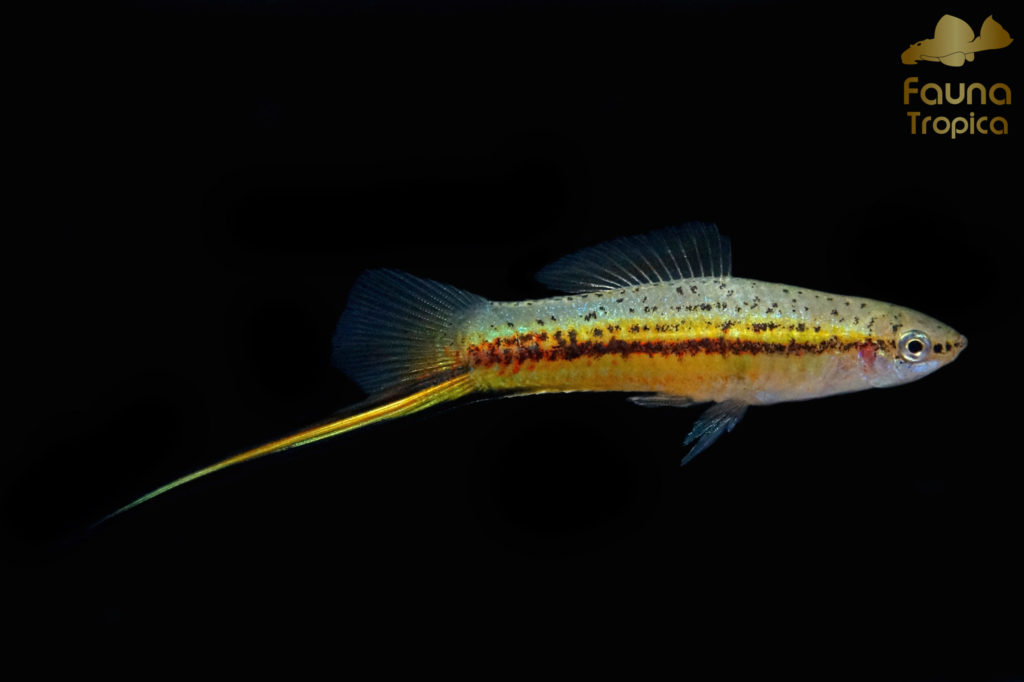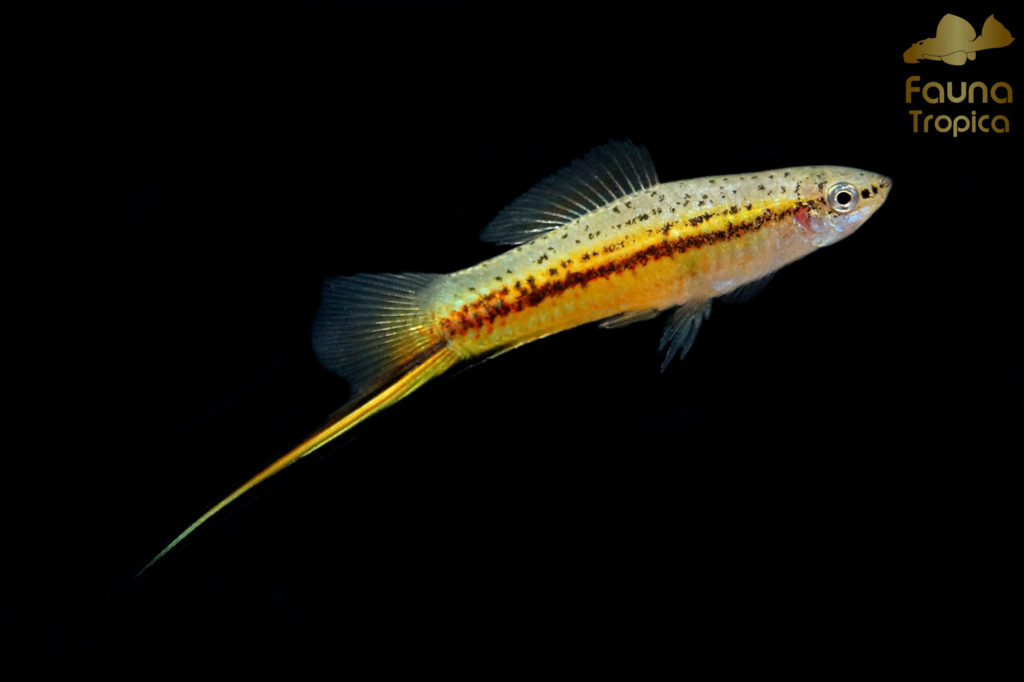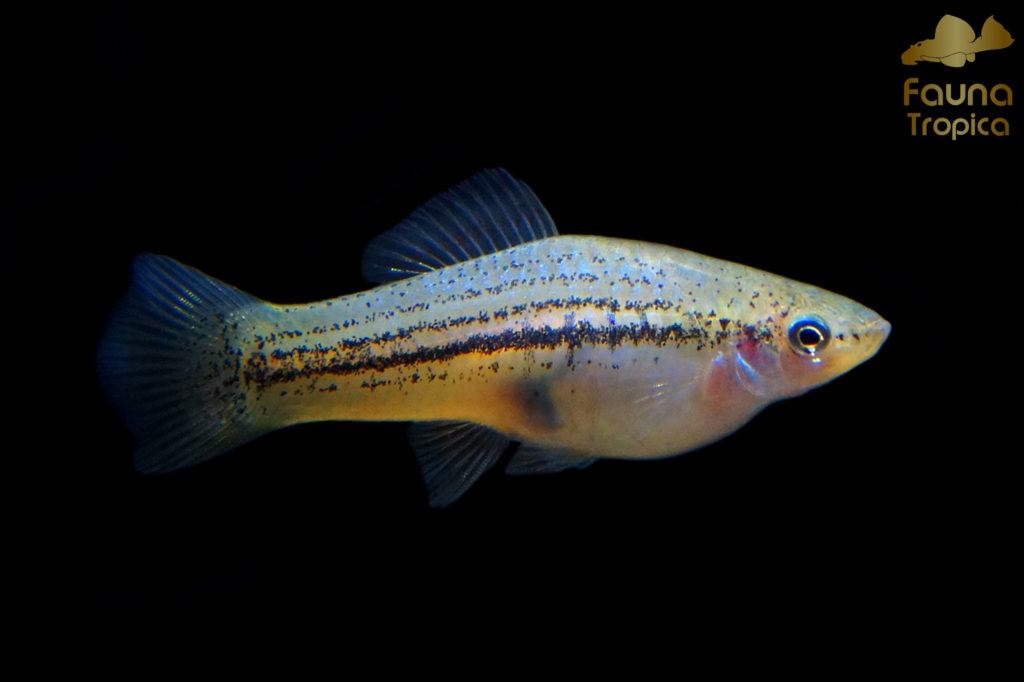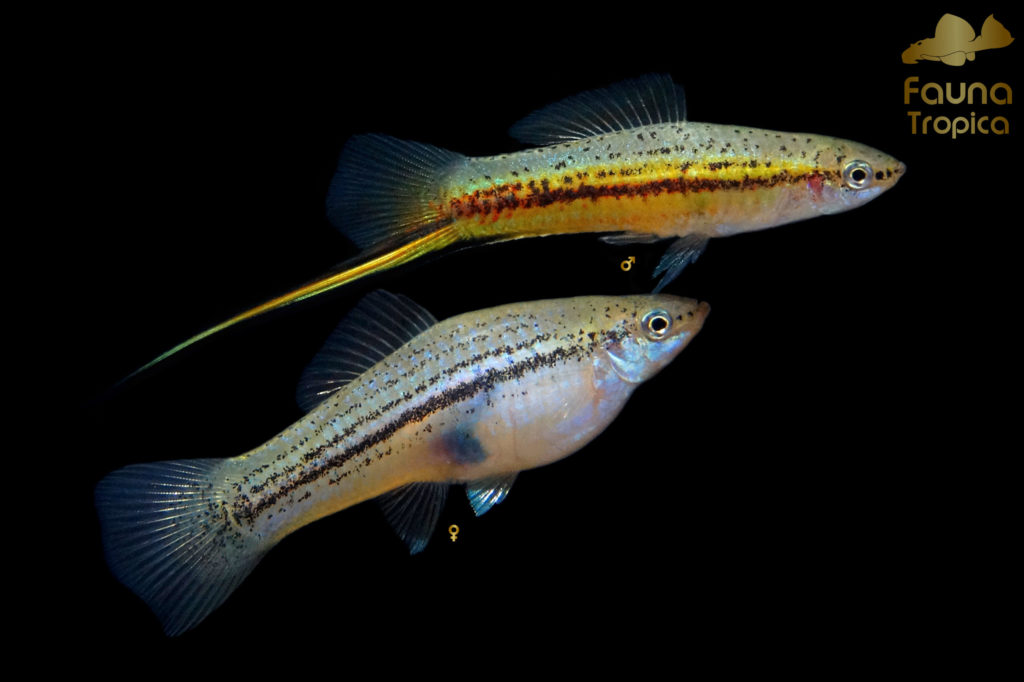
Scientific name: Xiphophorus hellerii “Yucatán 2”
Origin: Middle America / Mexico / Yucatán Peninsula
Maximum length: till 15 cm
Temperature: 22 – 28 ºC
Diet: Omnivore
- Taxonomy
- Description
- Distribution and habitat
- Diet
- Aquarium
- Sex difference
- Reproduction and breeding
Order: Cyprinodontiformes
Suborder: Cyprinodontoidei
Family: Poeciliidae
Subfamily: Poeciliinae
Genus: Xiphophorus
Species: Xiphophorus hellerii, Heckel, 1848
Xiphophorus hellerii "Yucatán 2", commonly known as swordtail, can reach a maximum size of around 15 cm (without sword). Females grow larger and more robust. The general figure of this fish is slender and long with a pointy head and the mouth faces to the surface. Males develop a long sword - like growth on the underside of the caudal fin.
The coloration of this wild forms males is beige on the upper half of the body and yellow-orange on the underside. In the middle of the body is a dark red stripe visible, which goes from the eye till the caudal fin. Many black spots are visible on top of this coloration. Dorsal- and caudal fin have a slight yellow to orange hue. The sword is black at the border with a yellow to orange stripe in the middle. Pelvic-, anal- and pectoral fins are transparent.
Females are bright beige on the top of the body and white on the underside. On the sides of the body a pattern of grey stripes are visible. Those stripes go from the eyes till the caudal fin. Many spots in grey to black are visible on top of this coloration. The dorsal fin can have a slightly orange hue. All other fins are transparent.
This species is an active swimmer, rarely seen without any movement. It searches for food on the surface. Other than that, this fish is mostly busy with mating and mating display. Males swim backwards in front of the female to attract her.
However, it is known that X. hellerii "Yucatán 2" males are generally calmer.
Swordtails are a common fish in the hobby but wild forms like "Yucatán 2", are rarely seen. Wild swordtails tend to grow larger but have fewer offspring than breeding forms.
Xiphophorus hellerii is a Middle American fish. It's main distribution is in Mexico, Guatemala and Honduras. The wild variant "Yucatán 2" comes from Mexico. Unfortunately, it is not known from which river it is caught exactly. It is only known that it originates from the Yucatán Peninsula.
In general X. hellerii enjoys fast streaming rivers with clear water. This fish is not sensible to the hardness, pH and temperature of water. It can therefore thrive in water with a temperature of 22 - 28 °C, a pH of 6,5 - 8,5 and a hardness between 10° - 30° dGH. Hence this might also be the reason why this fish survives and breeds in waters not being native to.
X. hellerii is a feral species in a lot of tropical and subtropical areas of the whole world.
Xiphophorus hellerii is omnivorous and eats in nature mostly small insects and their larvae, crustaceans, small fish, algae and water plants. This species orientates more on food on the surface.
In captivity it is possible to feed this fish with almost every fish food what is available on the market. To keep a fish healthy it is important and advisable to feed a varied diet. From flakes, granules, pastes, tabs, frozen to life food, every thing can be given.
With around 15 cm this fish grows rather large. Also it enjoys living in groups, which means more swimming space is necessary. Therefore an aquarium from 100 cm length upwards is necessary.
It is good to structure the tank with decoration, so that females have the chance to hide. Especially when the males chase the females for a long time, hiding possibilities are important. Also fine plants can help babies to survive in the aquarium with the parents. The aquarium should have a filter, lighting and, depending on the room temperature, an internal heater. Since this species lives longer in colder water X. hellerii shouldn't be kept over 25° C long term. Weekly waterchanges of about 50 % are also necessary to keep the fish healthy.
X. hellerii is a great fish for community set ups. It is a non aggressive and active swimming species. But it should be taken care that there are more females than males in the aquariums, since males are mostly busy with mating and mating display. Therefore this can cause stress for the females, if they don't get a break from time to time.
X. hellerii predates on small shrimps, small fish and baby fish, which is why youngsters should be separated from adult swordtails.
Sexing X. hellerii is in most cases really easy. So called "early maturing - males" develop their sexual traits already in the first weeks.
Males have a slimmer body figure and look longer. They develop a elongated caudal fin, which is what they call the sword. Males have a more vivid coloration than females and shows with wild forms mostly the typical red and yellow stripe on the sides of the body. The anal fin of males (gonopodium) is used as an sexual organ. It looks longer and thinner and can bend to the side. In comparison, males are more active swimming and try to impress females by swimming backwards in front or around them.

Females get more bulky and don't look so long. All their fins stay normal. The coloration is mostly a bit duller. When being pregnant, females develop a black "pregnancy - stain" in the after region and get a huge belly. Females swim in general more calm than males.

The only thing which makes sexing in early stages difficult, is the fact, that some males are "late maturing - males". Which means that they look for several weeks like a female and develop the sexual traits of a male rather late. Those males keep the typical higher body shape of a female, grow mostly larger and don't always develop male coloration. The gonopodium and the sword develops, on which a male can be identified.
Because of that, you hear often that X. hellerii can change its sex, which is so not true.

Xiphophorus hellerii is a live bearer, which means it doesn't lay eggs but incubates them in the belly. The babies are developed completely by the time they leave the mother belly.
Mating starts with the male trying to impress the female. This is done constantly over the day and consists of swimming around the female. Also swimming backwards in front of the female, to present the males sword is observable. The male then swims sideways to the female and fertilizes her by inserting his gonopodium into the females genital area. This is most common when females are giving birth or are shortly done with giving birth. The mating behaviour can stress the female, which is why there should be always more females than males in the tank. This to minimize the stress on a single female.
The female can store the sperm to fertilize eggs inside of her for several times. When pregnant, the female will grow a big belly and develops a black "pregnancy - stain" in the after region.
After 28 - 46 days (depending on the temperature), the female searches for a calm, well hidden spot, between plants or something similar. There she releases in the course of a day 20 - 150 babies (depending on how big the female is). Those babies are around 3 - 4 mm big. They are not good and not fast swimmers yet, which is why they need hiding spots. Are there non given, the adult fish, even the mother, predates on the young fish.
When breeding at home it is advisable to separate a female shortly before spawning into a own spawning tank and catch her out after she is done giving birth. This way the babies are in a separate tank, away from predators and easier to raise. You can feed the baby fish with really fine or dust food (grinded flakes, granules, etc.).
The babies develop rather fast and are sexually mature after around 3 months. Fertilization of young females is possible before they are sexually mature. This should be taken in account when breeding or keeping different strains of X. hellerii.
